Our input was featured in the Redfin blog about tips to create a butterfly garden.
Check it out:
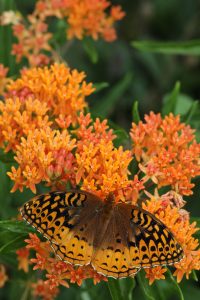
Great Spangled Fritillary on orange milkweed
Many people are familiar with monarchs and their migration, but most butterflies have their own unique life cycle. One is the beautiful Great spangled fritillary (speyeria cybele) They emerge from their chrysalis from late June to early July. Males will be seen searching for females. They will often be seen nectaring on milkweed flowers that are blooming at this time like common and orange milkweed. After they mate, males will die off and the females will go into a semi dormant like state, a summer nap if you will, and seldom be seen. Then in late summer early fall, they will start being seen again when they will start laying eggs.
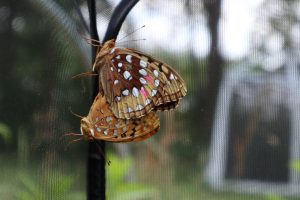
Butterflies overwinter in different ways. One of my favorites is the viceroy (the red spotted purple and the white admiral are identical). Viceroys overwinter as a little caterpillar in a half cocoon like contraption they build called a hibernacula. They eat most of a leaf and then build an open-ended silk structure within which they spend the winter. They secure the leaf to the stem to make sure they don’t fall to the ground like other leaves. In spring, when leaves come back out they come back out and resume eating. Looking for these hibernacula in winter can be a fun way to beat cabin fever. We had an ice storm yesterday, so I thought it would be fun to take a pic of a viceroy hibernacula coated in ice. In another month and a half or so, the little caterpillar will be back out and start eating again. (if you look close you can see the little threads the caterpillar used to make sure it stays attached to the stem)
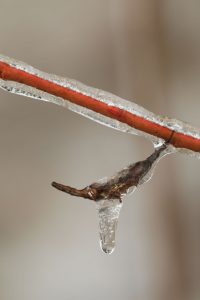
All swallowtail butterfly caterpillars in Michigan, regardless of species, have a unique defensive mechanism called osmeterium. When disturbed, the caterpillar is able to stick out and retract little horns at the top of their head. While the little orangish colored horns may themselves surprise a potential predator, the smell is what is really noticeable. I would describe it as a odiferous sweet smell. Many people describe as stinky and use the name “stink horns”. It’s never really bothered me. In fact, when I have been caterpillar hunting, it has often aided me in finding them, because the smell is so unmistakable. I know a swallowtail caterpillar is nearby when I smell it. This a a tiger swallowtail caterpillar with it’s osmeterium or “stink horns” out. When they stick them out they extend further than this but usually quickly retract much of it and then shortly after pull them entirely back in.
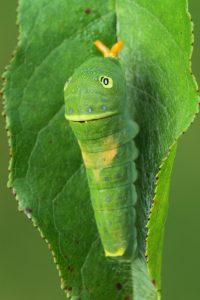
When I was a kid and would look for butterflies, tiger swallowtails always seemed like the prize. And the ones that always impressed me most were the ones with so much blue on the hind wings. Wow, did they just pop! When I got a bit older I learned that many swallowtails are sexually dimorphic, which means the males and females are distinctly different looking. Not all are like this, such as the giant swallowtail. Both sexes look similar. But with the tiger swallowtails, black swallowtails, and spicebush swallowtails, females have noticeably more blue on the hind wing. (Well, with the spicebush swallowtail, the males are a more blue-green and the females a metallic blue). Many other swallowtail species across the world are also sexually dimorphic. A phrase that many butterfly enthusiasts will say to remember this is “girls have blue skirts” In this picture we took you can clearly see the difference in the female on top and the male on the bottom. Often during the summer we will be approached by people who share pictures of swallowtails in the yard and we’ll react, “what a beautiful female (or male)!” “But how can you tell?” Girls have blue skirts.
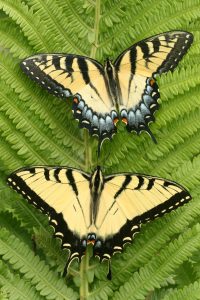
One thing that never seems to quit fascinating me is watching a newly hatched (eclose) butterfly or moth expand it’s wings. Comparing the size of the butterfly/ moth to the pupa it came out of is impressive. Watching the wings go from shriveled looking little things to large wings capable of flight is a marvel. The luna moth is even more intriguing to me because it’s tails are tucked in and don’t flop out until further in the wing development as you can see in this series of photos that I took.
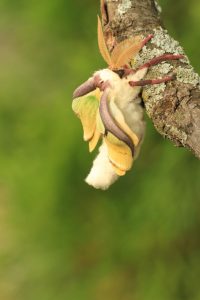
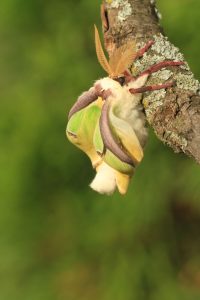
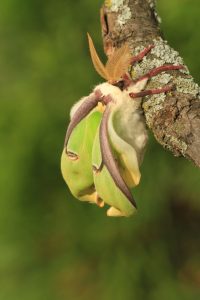
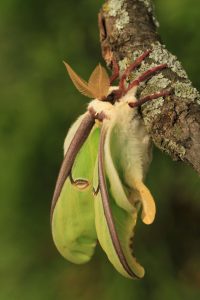
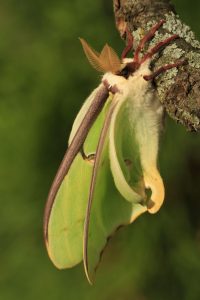
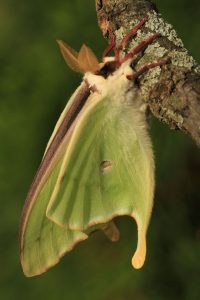
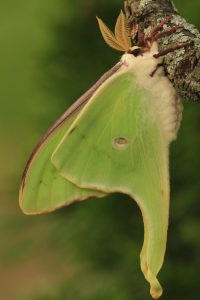
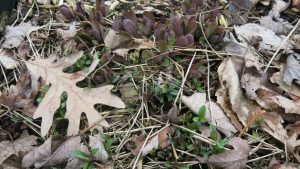
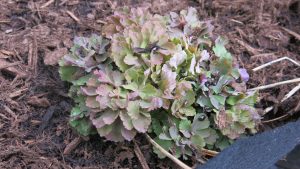
Well, despite there being a lot more days with below average temps than at or above average where we live, signs of spring are everywhere and our plants are starting to come up. I even saw my first butterfly of the year. A mourning cloak, which overwinters as an adult butterfly. We overwinter our plants outside to try to keep them on a natural schedule. Some of our plants keep some green all winter, others are just starting to poke through the ground and still others need a bit warmer temps before they start sending up new growth. We have sold some of our plants through the winter in a dormant state and list them as such on our website and Etsy store. As they start popping up for the year, we list change their listing to reflect this. We have a wide selection of plants for a butterfly pollinator garden and add new ones every year. The ones we have available now are all one year old, but we are currently starting seeds and as those have sufficient enough growth, we will be listing them too. Our plants can be currently be purchased through this website https://www.blazingstarbutterflygarden.com/ or our Etsy store Etsy Blazing Star Butterfly Garden We also have pickups by appointment at our location. Here is a list of what we have available and hope to have soon:
Native Plant ready for 2022 season:
ZIZIA AUREA – GOLDEN ALEXANDERS
Silene regia ROYAL CATCHFLY
Silphium laciniatum COMPASS PLANT
Desmodium canadense SHOWY TICK TREFOIL
Senna hebecarpa WILD SENNA
VERBENA STRICTA – Hoary VERVAIN
VERBENA HASTATA – BLUE VERVAIN
TRADESCANTIA OHIENSIS – OHIO SPIDERWORT
AQUILEGIA CANADENSIS – COLUMBINE
AMORPHA CANESCENS – LEAD PLANT
AMSONIA ILLUSTRIS – OZARK BLUESTAR
BAPTISIA AUSTRALIS – BLUE WILD INDIGO
BOEHMERIA CYLINDRICA – SMALLSPIKE FALSE NETTLE
ECHINACEA PURPUREA – PURPLE CONEFLOWER
Ratibida pinnata YELLOW CONEFLOWER
Eryngium yuccifoum RATTLESNAKE MASTER
Symphyotrichum novae-angliae NEW ENGLAND ASTER
Lobelia cardinalis CARDINAL FLOWER
Lobelia siphilitica GREAT BLUE LOBELIA
Eutrochium maculatum JOE PYE WEED
Physostegia virginiana OBEDIENT PLANT
Agastache foeniculum ANISE HYSSOP
Penstemon digitalis FOXGLOVE BEARDTONGUE
Penstemon cobaea SHOWY BEARDTONGUE
Monarda fistulosa BERGAMOT
GENTIANA FLAVIDA – CREAM GENTIAN
LIAMNA REMOTA – KANKAKEE MALLOW
LUPINUS PERENNIS – WILD LUPINE
MERTENSIA VIRGINICA – VIRGINIA BLUEBELLS
PENSTEMON GRANDIFLORUS – LARGE-FLOWERED BEARDTONGUE
PHLOX PILOSA – PRAIRIE PHLOX
POLEMONIUM REPTANS – JACOB’S LADDER
PORTERANTHUS STIPULATUS – WESTERN INDIAN PHYSIC
RATIBIDA COLUMNIFERA – LONG-HEADED CONEFLOWER
RUDBECKIA SUBTOMENTOSA – SWEET BLACK-EYED SUSAN
RUELLIA HUMILIS – WILD PETUNIA
SALVIA AZUREA – BLUE SAGE
ASCLEPIAS SULLIVANTII – PRAIRIE MILKWEED
ASCLEPIAS SPECIOSA – SHOWY MILKWEED
ASCLEPIAS PURPURASCENS – PURPLE MILKWEED
Asclepias incarnata ROSE/ swamp MILKWEED
Asclepias verticillata WHORLED MILKWEED
Asclepias tuberosa BUTTERFLY milkWEED
ALLIUM CERNUUM – NODDING ONION
ECHINACEA PALLIDA – PALE PURPLE CONEFLOWER
HIBISCUS LAEVIS – ROSE MALLOW
LESPEDEZA CAPITATA – ROUND-HEADED BUSH CLOVER
Helenium autumnale SNEEZEWEED
ANDROPOGON GERARDII – BIG BLUESTEM
SCHIZACHYRIUM SCOPARIUM – LITTLE BLUESTEM
BOUTELOUA CURTIPENDULA – SIDE-OATS GRAMA
BOUTELOUA GRACILIS – BLUE GRAMA
ELYMUS CANADENSIS – CANADA WILD RYE
PANICUM VIRGATUM – SWITCH GRASS
SORGHASTRUM NUTANS – INDIAN GRASS
SPOROBOLUS HETEROLEPIS – PRAIRIE DROPSEED
ZIZIA APTERA – HEART-LEAF GOLDEN ALEXANDERS
VIOLA PEDATIFIDA – PRAIRIE VIOLET
Trees:
pawpaw
Choke Cherry,
Gray dogwood
Black cherry
sweetgum
Spicebush
Nonnative perennials:
Ruta Graveolens Garden Rue
Levisticum officinale Loveage
Non native annuals ready after MI frost free/ mid may:
Gomphocarpus physocarpus hairy balls milkweed
Asclepias curassavica Tropical Milkweed
Tithonia rotundifolia Mexican sunflower
Verbena bonariensis tall verbena
Natives New for 2022 but not yet available
EUTROCHIUM PURPUREUM – SWEET JOE PYE WEED
EUPHORBIA COROLLATA – FLOWERING SPURGE
FILIPENDULA RUBRA – QUEEN OF THE PRAIRIE
GALIUM BOREALE – NORTHERN BEDSTRAW
GENTIANA ANDREWSII – BOTTLE GENTIAN
GENTIANOPSIS CRINITA – FRINGED GENTIAN
GEUM TRIFLORUM – PRAIRIE SMOKE
HELIANTHUS GROSSESERRATUS – SAW-TOOTH SUNFLOWER
Campanula Americana TALL BELLFLOWER
LIATRIS LIGULISTYLIS – MEADOW BLAZING STAR
LIATRIS PYCNOSTACHYA – PRAIRIE BLAZING STAR
MIMULUS RINGENS – MONKEY FLOWER
MIRABILIS NYCTAGINEA – WILD FOUR O’CLOCK
PENSTEMON CALYCOSUS – CALICO BEARDTONGUE
PENSTEMON HIRSUTUS – HAIRY BEARDTONGUE
PHLOX MACULATA – WILD SWEET WILLIAM
PYCNANTHEMUM VIRGINIANUM – MOUNTAIN MINT
SISYRINCHIUM ANGUSTIFOLIUM – STOUT BLUE-EYED GRASS
THERMOPSIS CAROLINIANA – BLUE-RIDGE BUCKBEAN
ASCLEPIAS EXALTATA – POKE MILKWEED
VERONICASTRUM VIRGINICUM – CULVER’S ROOT
BAPTISIA AUSTRALIS VAR. MINOR – DWARF BLUE INDIGO
BAPTISIA SPHAEROCARPA – LARGE YELLOW WILD INDIGO
BAPTISIA TINCTORIA – SMALL YELLOW WILD INDIGO
CHASMANTHIUM LATIFOLIUM – RIVER OATS
TRIDENS FLAVUS – PURPLETOP
KOELERIA MACRANTHA – JUNE GRASS
VERBESINA ALTERNIFOLIA – WINGSTEM
VERNONIA MISSURICA – MISSOURI IRONWEED
ANAPHALIS MARGARITACEA – PEARLY EVERLASTING
SYMPHYOTRICHUM OBLONGIFOLIUM – AROMATIC ASTER
BAPTISIA ALBA – WHITE WILD INDIGO
BLEPHILIA CILIATA – DOWNY WOOD MINT
CALLIRHOE INVOLUCRATA – PURPLE POPPY MALLOW
CEANOTHUS AMERICANUS – NEW JERSEY TEA
ECHINACEA PARADOXA – BUSH’S CONEFLOWER
Chelone glabra TURTLEHEAD
Penstemon calycosus CALICO BEARDTONGUE
Liatris aspera rough BLAZING STAR
LiaLiatris spicata marsh BLAZING STAR
tris cylindracea DWARF BLAZING STAR
Cirsium muticum SWAMP THISTLe
DODECATHEON PULCHELLUM – SOUTHERN SHOOTING STAR
Geranium maculatum WILD GERANIUM
Silphium perfoliatum CUP PLANT
It is still winter here in Southwest Michigan and if you are like me, longing for warmer weather and “butterfly season” to begin. The term “Cabin Fever” feels like it has a lot of meaning. Although most butterflies aren’t really active until at least May, there are signs it’s getting closer. Spring officially starts on March 20, but you may hear the term meteorological spring which basically divides the seasons by month. So March, April, May, is classified as spring. Still doesn’t feel like it, but this is the first week in seemingly forever that the high temp every day is forcasted to get above 32F/0C. It also appears that some animals have started to notice.
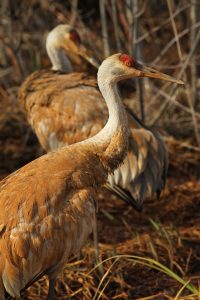
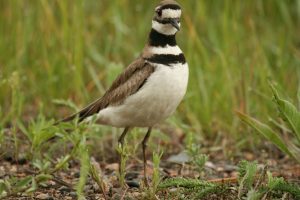
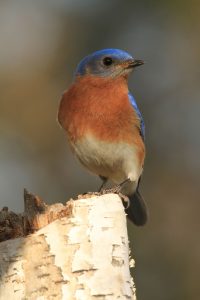
There are some birds that do not overwinter very much further south than Michigan. Some might not even migrate at all but find a good location to hunker down nearby. When a little warmth arrives they start moving around looking for suitable future nesting spots, returning to established ones, and establishing territory. Some that I have seen (or heard) recently are the sandhill crane, bluebirds, and killdeer. All who have easily recognizable calls, and in the case of the sandhill crane…loud!
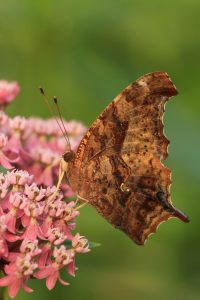
So what about butterflies? It may be a while yet, but some butterflies overwinter as adults, finding safe places to overwinter. The mourning cloak, questionmark, and comma butterflies all overwinter this way. They have been known to come out on warm sunny winter and early spring days to sun themselves and possibly feed on oozing tree sap (another spring sign) I haven’t seen one yet, but someday soon?
It’s winter and we are getting cabin fever wishing butterfly season would return. Butterflies overwinter in each of their stages (egg, larva, adult) depending on what species. One of the more easier species to find in winter, depending on your vision, are our “limenitis twins” The viceroy (limenitis archippus) and the red spotted purple (limenitis arthemis astyanax). Their caterpillars overwinter in a small cocoon like structure, a hibernacula, where the caterpillars sit and wait for spring. Both are found in our region of Michigan. In my observation, they do seem to have some differences in habitat preference. Red spotted purples seem to be more common near woods and viceroys more in open areas near wetlands
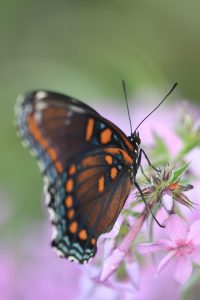
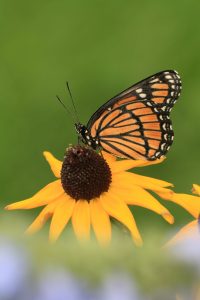
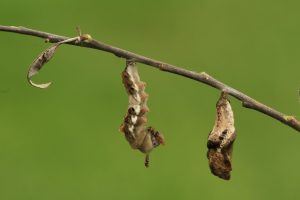
These species of butterflies are known as mimics. The Viceroy mimics the monarch amd the Red spotted purple mimics pipevine swallowtails, minus the tails. The butterflies they mimic are distateful or toxic so it appears to offer some protection from predators.
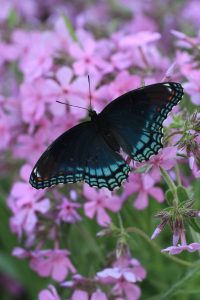
Despite looking very different as adult butterflies, the caterpillars are identical. They primarily eat the same hosts but seem to have favorites. Red spotted purple tend to favor choke cherry or black cherry and viceroys seem to favor willows. Both will readily use cottonwood or aspen as well. (This is probably the reason for my previously mentioned habitat prefernces). The adult butterfly will usually lay its egg at the top of the very tip of the leaf. After the caterpillar hatches it will work on eating the sides of the leaf leaving the midrib. This tends to make them easy to find if you want to observe them in the wild. The images I took were on the side of the leaf which is not typical, but you can still see how the egg looks and how they leave the vein or midrib.
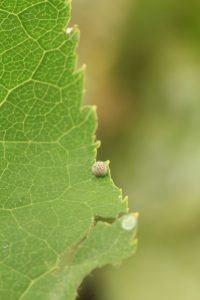
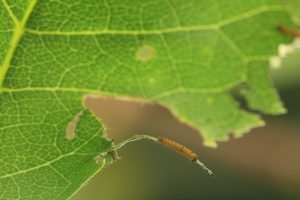
As the caterpillar matures it can be either green or brown and resembles bired poop. When disturbed, the caterpillar will arch its head down with its antennae out. To me its antennae look a lot like an ant which makes me wonder if it offers some protection as many insects avoid ants.
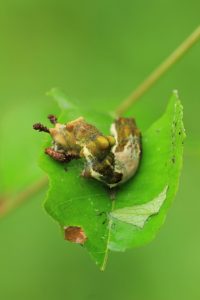
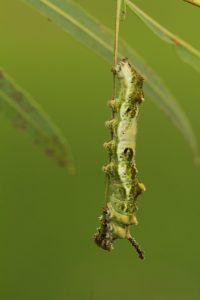
Here in Michigan both the red spotted purple and viceroy will have two generations and a possible third. The overwintering caterpillars will make a chrysalis in May and then the following generation will make a chrysalis in mid summer.
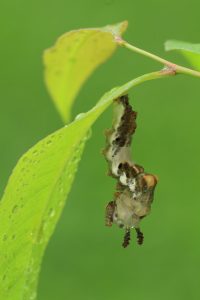
As the days get shorter and nights get cooler, the small caterpillars will make a hibernacula to overwinter. The caterpillar will attach these small open ended cocoon like structures to the branch and remain there all winter. The caterpillars can be seen crawling around on warm fall days, but no longer eats. When the days get cold it will stay inside. Even on the coldest of winter days, the little caterpillar can be seen inside. It can be a fun activity to beat the winter blues going out and looking for the overwintering limenitis caterpillars!
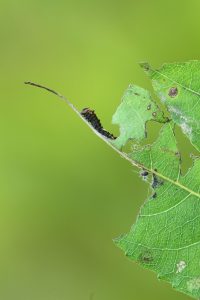
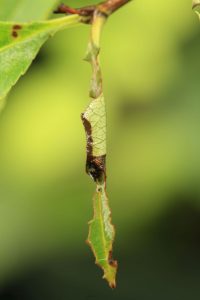
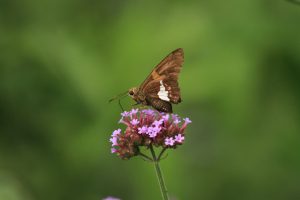
(Silver spotted skipper on tall verbena)
It makes sense that native plants are great for pollinators as they have a history of working together. Even so, we’ve got some favorites that aren’t native too. Here are our four favorites that we sell: Tithonia, Tall Verbena, lovage, and rue.
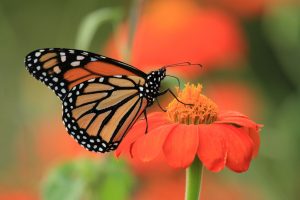
(Monarch butterfly on tithonia flower)
Tithonia (also called Mexican sunflower) is native to Mexico and from what we have read, is a common roadside plant in areas. It gets incredibly tall, 5-8 ft and covered in bright orange flowers that pollinators love. It loves the summer heat and grows like crazy when hot and it’s tolerant of dryer soils. This plant is not only a pollinator magnet, but also loved by hummingbirds. It continues blooming right up to frost and has lots of nectar for migrating monarchs. I tell people who enjoy photography to get these plants and then just go stand out by them in summer. The action never ends. The only thing that is a downer is that it gets so big, some people don’t have room and that it is an annual (gotta replant each year), which surprises many because of it’s size.
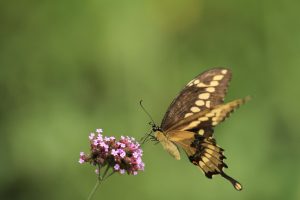
(Giant swallowtail nectaring on tall verbena)
Tall Verbena is another fantastic nectar plant that butterflies and other pollinators love (hummingbirds too!). It gets 3-5ft with narrow stems and light pink/ purple flowers. It’s a very adaptable plant. We get a lot of daytime flying sphinx moths (hummingbird clearwing/ white lined sphinx) at ours. Zebra swallowtails seem particularly fond of it too. It’s foliage is very similar to it’s native relatives, blue vervain and hoary vervain. This is another annual. One negative I have noticed about it is that it is a good self seeder and one needs to watch to make sure it doesn’t show up where it is not wanted.
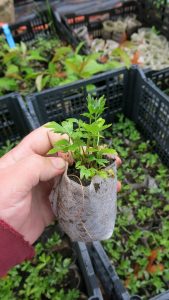
(lovage starter plant)
Lovage is a perennial herb that gets the nickname “poor mans celery” because of it’s similar taste. It is in the same family as celery and other garden plants like dill, fennel, and carrot. Like these it is the host for black swallowtails. The reasons I think these are great plants is that unlike it’s garden relatives, lovage is a perennial. It also loves cool weather and grows quickly in the spring. When the overwintered black swallowtails start emerging from their chrysalis in spring, lovage has lots of foliage for their caterpillars. Lovage doesn’t really like heat, so they can look haggard in summer, but bounce right back in fall and survive frosts till we get a good freeze.
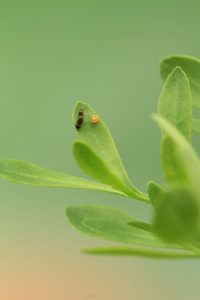
(Baby Giant swallowtail caterpillar and egg on rue)
Rue is another perennial herb. It generally stays under 3ft and has woody looking stems from which it sends out new growth in spring. It gets little yellow flowers in early summer. I often get asked what pollinators like the flowers and it doesn’t seem to be a favorite of many, but the one I do notice on them are mud dauber wasps. Mud daubers are beautiful (black and metallic blue/ purple), not aggressive like some wasps, and good pollinators. The great thing about rue is that it is the host for both giant swallowtails and black swallowtails, which use hosts from different families. With a rue plant you can find caterpillars of either and witness either species female butterflies laying eggs. One thing to be careful of is that the foliage can cause a rash in susceptible people.
We anticipate having all these plants available this season.
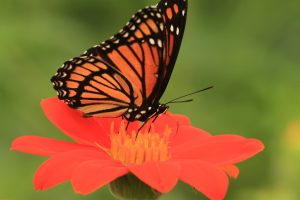
(Viceroy butterfly on tithonia)
